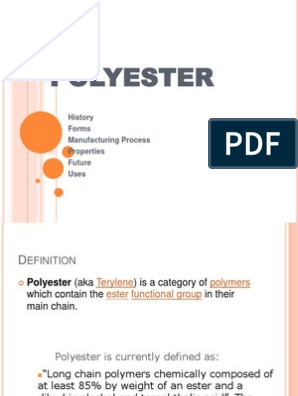0% found this document useful (0 votes)
141 views17 pagesPolyester: Polyester Is A Category of Polymers That Contain The Ester Functional Group in Their Main Chain
Polyester is a polymer made through a condensation reaction between dibasic acids and dihydric alcohols. It is most commonly produced using terephthalic acid and ethylene glycol to make polyethylene terephthalate (PET). PET is the most widely produced synthetic fiber and is known for its low cost, easy processability, and excellent performance properties. Polyester has high strength, elastic recovery, is hydrophobic and resistant to damage from light, chemicals, insects and microbes. Its major uses include clothing, home furnishings, automotive and other transportation applications, composites, and fiberfill.
Uploaded by
Anila AftabCopyright
© © All Rights Reserved
We take content rights seriously. If you suspect this is your content, claim it here.
Available Formats
Download as PPTX, PDF, TXT or read online on Scribd
0% found this document useful (0 votes)
141 views17 pagesPolyester: Polyester Is A Category of Polymers That Contain The Ester Functional Group in Their Main Chain
Polyester is a polymer made through a condensation reaction between dibasic acids and dihydric alcohols. It is most commonly produced using terephthalic acid and ethylene glycol to make polyethylene terephthalate (PET). PET is the most widely produced synthetic fiber and is known for its low cost, easy processability, and excellent performance properties. Polyester has high strength, elastic recovery, is hydrophobic and resistant to damage from light, chemicals, insects and microbes. Its major uses include clothing, home furnishings, automotive and other transportation applications, composites, and fiberfill.
Uploaded by
Anila AftabCopyright
© © All Rights Reserved
We take content rights seriously. If you suspect this is your content, claim it here.
Available Formats
Download as PPTX, PDF, TXT or read online on Scribd
/ 17





























































































